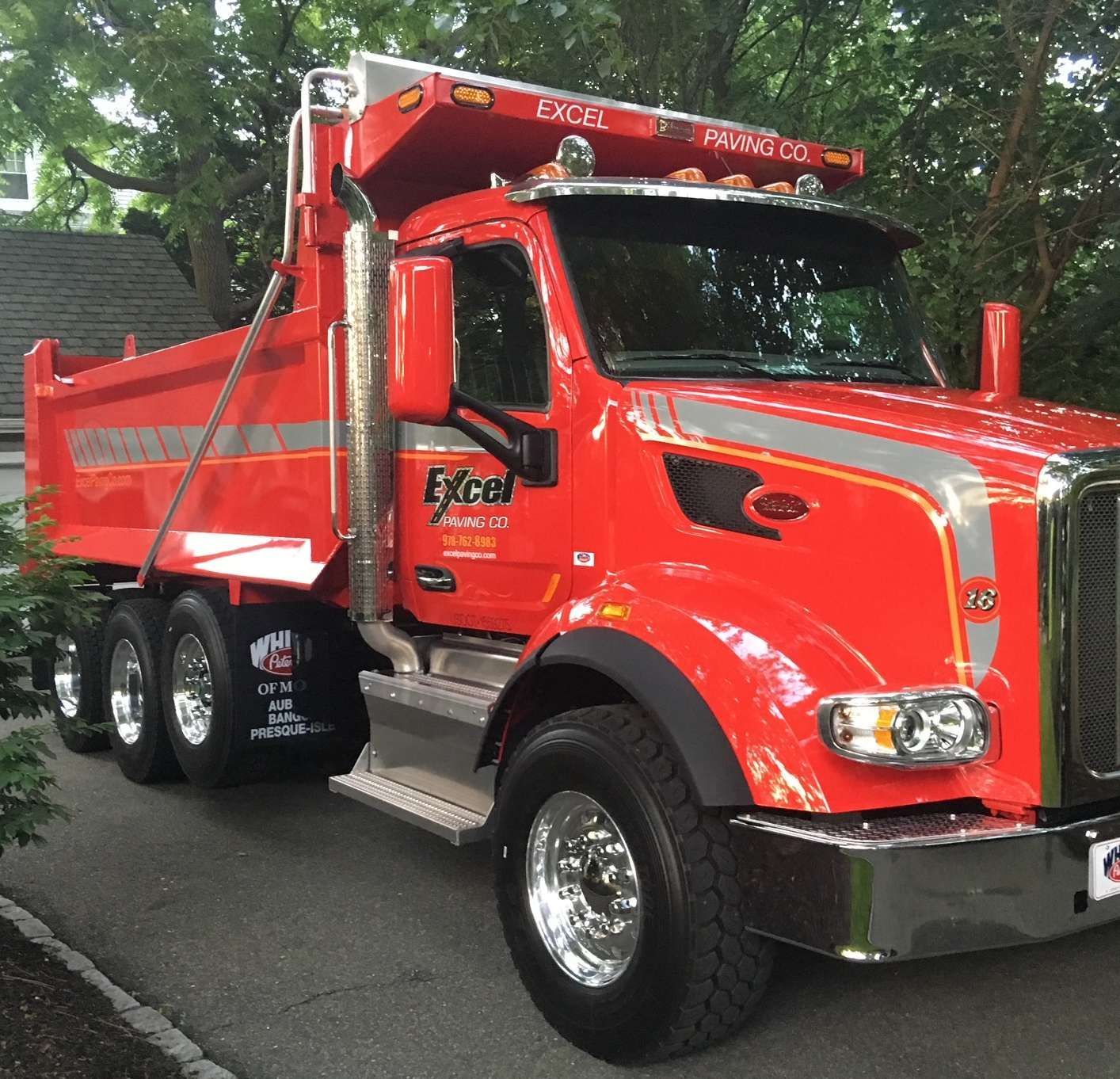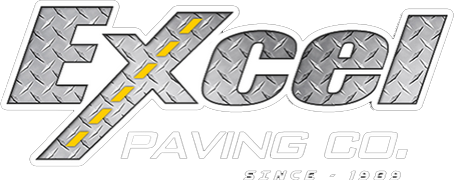Asphalt Paving BY Excel Paving

As an example, notice that the operator of the Roadtec RX-600e is keeping the truck bed from overfilling. You end up with a mess for the ground personnel to take care of if you don’t keep an eye on capacity and production and speed while milling the lane.
It’s not just more tons, it’s more efficiency that enhances the project manager’s milling operation
When using one set of trucks to haul millings from the job to the plant and then haul mix from the plant to the paving end of the job, you need proper quality control measures in place to protect yield. You want to use quality control measures to keep stuck millings from melting into your on-spec mix from the plant. And here’s one for the veterans reading today: prevent the paving crew from catching up to the milling crew. I’ve personally seen the line of haul trucks full of perishable mix sitting at the ready, the drivers racking up billable hours while the milling crew wondered where to put millings. The entire project comes to a standstill if the paver has nowhere to put the mix from the trucks. Let’s look at ways to avoid big milling project mistakes through better project management.
This is a decent milling job. If you don’t have automation on the milling machine telling you that you’re doing it right—and even if you do—lay a 4-foot level down across the lane. This is the best way to double-check your work behind the mill.
Set the Speed
One of the worst things a project manager can do is try to break the record for the number of square yards the milling crew can take out in an eight-hour shift. I know that’s a little sensationalized, but when we demand more and more productivity out of workers and machines, when we glorify how fast a crew gets a project completed over how well they performed the job, we set the crew up to take shortcuts. Instead, the project manager needs to convince the milling machine operator to take a look at the process.
Let’s start the process at the transverse joint. Because the cutter drum is round and the teeth set in a spiral pattern around it, the “line” where the cutter sets into the layer of pavement gets a 50-degree slope or curve down into it. The cutter is round so it only cuts a straight line longitudinally. It will give you a scalloped edge. To make the transverse joint straight, the milling team will want to bring in a small mill, like a two-footer, and work it directly across the lane to get the square butt joint you need for good paving afterward. You’ll perform this perpendicular cut with the two-foot mill at the beginning and end of the milling pass.
Another aspect of the milling process is filling trucks. No matter how many haul trucks are lined up to be filled, the operator must not accept the mindset of “go go go” to hurry and get rid of the trucks. Each truck should be dispatched in a timely fashion from the yard to give drivers enough time to reach the jobsite, pull in to receive a coating of release agent, drive ahead of the mill to accept millings, and then drive off to the plant for unloading once the bed is adequately filled.
Filling a truck to an adequate level means mounding the material correctly in the front, back and center of the bed without overflow. In the event of overflow, ground personnel have to step in to clean up material with shovels and/or a skid steer, wasting time and fuel.
The milling machine operator is the one who sets the speed at the operator’s station. If he sets it too fast, the cutter drum under the machine responds unfavorably. It will gouge the teeth into the road, tearing and ripping at the layers of pavement. What the operator will see behind the machine is a mess of gouges with no discernable pattern.
What he wants to see is the herringbone pattern of all the teeth making contact and grinding out uniform lines of pavement.
Avoid Doubling, Tripling Work
As the operator looks back at the pattern behind the mill, if he sees the pretty chevron pattern and a uniform depth of the cut, he can feel confident that the paving team will have an easier time of hitting its target for yield. Quality control for depth and slope is easy enough with a 12-foot straight edge placed across the lane. See the sidebar on page xx for some safety tips on checking depth of the cut.
Another place to look for signs of quality is at the discharge chute. As he watches the material coming off the belt into the truck, the operator should look for chunks or clumps of material larger than millings. If it’s coming out chunky, it’s a sure sign that the mill is traveling too fast. It’s also a sign that someone else will have more work to do.
The material from the pavement is a recyclable product that goes back to the plant for stockpiling, fractionating, screening, etc. If the product leaving the discharge conveyor is full of chunks, it will have to be crushed when it gets to the plant. That equals additional money and time not originally planned for this project, because the milling operator has not done his job correctly. This also means the pavement is left with holes and dips that will require additional mix to fill, causing new calculations for yield and possibly for production so the paving crew can get a uniform roadway.
If the project manager—or DOT inspector—sees the need, he may call for the milling crew to re-mill the surface to get it right. Doubling up on any portion of a project is a recipe for lost profit. A practice that’s gaining momentum is the use of automation for the milling crew. If the team is using automation, one operator can typically run both sides of the machine with little fear of gouging the pavement layers or putting in a trench no one wanted. If not using automation, the crew needs to have exact edges to match.
Let Trained Employees Do the Work
The project manager needs to take the milling machine operator aside to show him how the end result should appear. Instill pride of workmanship into the operator. The boss may want “more tons,” but he also wants a job well done.
One way to get the job done well is to pay attention to the machine. It will tell you when teeth need to be changed. Rather than worrying about the cost of 18 to 19 teeth today and 16 to 17 teeth tomorrow, consider the ragged cut job you’ll have if you allow teeth to wear down. By getting a uniform cut job all the way across, the surface will be set up correctly for the paving crew. Don’t be cheap—change the teeth when you need to.
Recycling operations try to minimize the number of times material must be handled. When the milling crew sends material that needs extra handling back to the plant, it adds extra time—thus cost—to the job. Photo courtesy of Team Eagle.
In some states, such as South Carolina, the problems contractors have had in the past guaranteeing that good, uniform cut across the job on a consistent basis has led the state DOT to reduce the practice of milling. They’ve turned instead to micro-milling with a 1,200-tooth cutter drum that requires a slower speed on all interstate lanes. In the state of Georgia, the DOT often specifies micro-milling, or profiling instead of milling several inches.
You just cannot profile at a high rate of speed. These states have essentially forced their own quality control upon the contractors. Rather than set yourself up for a state-mandated speed limit, set your own quality control speed and parameters, and train your equipment operators to hold true to those parameters.
When the milling crew is on the job, each member of the crew should be well versed in the operation, maintenance and safety protocol of the milling equipment. In the event the paving crew has need to touch up milled areas, make sure a member of the milling crew or a paving crew member trained in milling operation is available. You don’t want to risk an untrained operator maneuvering a $750,000 piece of machinery. Know the boundaries of the machine.
Remember that milling machines have a high center of gravity and a sensitivity to slope. There’s a slope level on the machine. If you go past it, the machine will tip over. At the least, you wreck a half-million dollar machine; at the worst, you crush workers or passing motorists.
Trained workers will keep a steady pace of milling the half lane, setting back, milling forward again, etc. They’ll keep the trucks filled to proper levels with uniform material from a well-maintained cutter drum working at a steady speed. That steady speed depends upon the surface being milled, the depth of the cut, the type of pavement, the makeup of the pavement and its structure, and more.
We can say to set the speedometer for 50 or 60 feet per minute, but even that typical pace might be too fast if removing a 12-foot-wide, 8,000-PSI PCC pavement to a depth of its rebar. The project manager then keeps a well-trained paving crew working at a steady pace behind the milling crew with haul trucks spaced to keep perishable mix arriving only as it’s needed. When a mill-and-fill project has both stages ongoing, scheduling takes on increased importance.
Despite the number of trucks lined up with or without mix, the milling machine operator can’t give in to pressure to speed up his process. The team doesn’t win if the milling machine is galloping toward an imaginary finish line. Quality will lose every time.
John Ball is the proprietor of Top Quality Paving, Manchester, N.H. For more information, contact him at
(978) 590-7283.
Change Depth-Check Practice
At this time, it’s common to see the ground man check the depth by inserting the ruler behind the cutter drum of the milling machine. He will approach the cutter drum housing, brush some material away with his foot, and then lean in to insert the ruler. This practice must stop.
In the event that the cutter makes contact with a large rock, with a manhole cover, a sewer cap, or with some other obstruction that the crew has not anticipated, the cutter can actually kick back, running over the worker. He could lose a foot, his leg or his life.
The better depth-check is at the back of the machine. With full communication and all ground personnel and the milling machine operator aware that the ground man is taking the depth-check, the worker can approach the back of the machine, insert the ruler in the path, and read the measurement. Please note that this type of maneuver involves communication so all relevant parties know where he is and what he’s doing. By entering the machine operator’s blindspot, the worker puts himself in danger. His safety buddy should be in direct line-of-sight with the machine operator and with the worker. If anything goes wrong, that safety buddy can sound the alarm or use the pre-arranged communication signals to get the milling machine stopped immediately.



